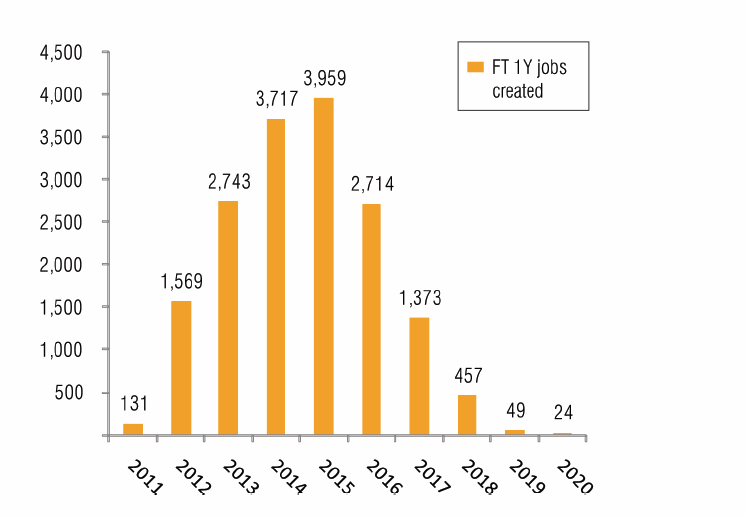UNIVERSITY OF CALIFORNIA, IRVINE
INSTITUTE OF TRANSPORTATION STUDIES
INTRODUCTION
Highlighting the importance of federal investment in an interstate highway, President Eisenhower declared in his 1955 State of the Union address: “A modern highway system is essential to meet the needs of our growing population, our expanding economy, and our national security.” Fifty-five years later, President Obama also announced a transportation plan that would produce jobs and enhance national security. But this 21st Century plan is considerably different from Eisenhower’s, in that if successful, it would dramatically reduce our dependence on cars and the nation’s demand for oil.
In January 2010, President Obama announced the recipients of an unprecedented $8 billion federal stimulus grant that will jumpstart high-speed rail service on thirteen corridors across the United States. California is to receive the largest share of any state, $2.34 billion, with $2.25 billion allocated to a dedicated high speed rail system (to be matched by state funds from Proposition 1A), and the remainder allocated toward regional transit projects. The likely scenario is that the majority of the funds arriving in California will be spent on construction in Southern California on a high-speed rail line from Los Angeles to Anaheim.
Excited by the potential of this investment for their constituents, many key political leaders are already touting the myriad benefits of a fast, convenient, and efficient intercity rail system, including lower carbon emissions, improved mobility, jobs and economic revitalization, and less dependence on foreign oil, which in turn will strengthen our national security. United States Secretary of Transportation Ray LaHood recently pointed out in a press release that highspeed rail will “not only … create good jobs and reinvigorate our manufacturing base, it’s also going to reduce our dependence on fossil fuels and help create livable communities. I have no doubt that building the next generation of rail service in this country will help change our society for the better.”
Just as the Interstate Highway System transformed the way Americans live and where they work, high-speed rail has the same transformative potential. In the arena of transportation, it is a disruptive technology, with the power – as LaHood noted – to reshape entire regions and communities in a more sustainable manner. Southern California will be ground zero for this transformation: of the seven corridor segments identified in the California High Speed Rail Authority business plan, Los Angeles to Anaheim is currently the most advanced in the planning and environmental review process, and could see limited service commence as early as 2017.
For a long time, Southern California has been known as a desirable place to live and work. The region has added over 2 million people since 2000. Despite a dramatic economic downturn, it is still projected to add over 6 million additional people over the next 30 years.
All of the Southern California counties have invested in transportation infrastructure during the last twenty years. Orange County, in particular, has seen heavy investment – mostly through the addition of freeway lanes, a toll road network, additional high occupancy vehicle (HOV) lanes, the inauguration of commuter rail service and surface street improvements, much of which was funded by a one-half cent sales tax known as “Measure M”.
For the most part, these investments have delivered incremental improvements and capacity enhancements to the existing transportation networks. Highspeed rail will, on the other hand, bring to the Southern California region a new and faster mode of interregional travel, with substantial time-saving and cost advantages over both auto and air networks for the vast majority of destinations served by the proposed CAHSR corridor. This study will analyze some of the benefits likely to be reaped from high-speed rail, specifically in Orange County, and what strategies are needed to ensure that cities around the region can take advantage of the investment about to be made in California. It will also examine high-speed rail’s impact in relation to recent legislative initiatives that mandate a reduction in statewide greenhouse gas (GHG) emissions (AB 32), and the coordination of regional land use and transportation planning (SB 375) in support of those reduction targets.
AB 32 and SB 375 have recently come under attack by those who perceive a fundamental conflict between economic growth and environmental protection. In particular, some economists predict that regulatory curbs on GHG emissions could raise energy prices for California consumers and businesses, making the state less competitive and damaging the prospects for a recovery. Proposition 23, currently on the November 2010 statewide ballot in California, would suspend implementation of AB 32 until long-term unemployment in California reaches a pre-recession level of 5.5% for at least four consecutive quarters.1 Proposition 23, if passed, would also put SB 375 into jeopardy since the two pieces of legislation are highly interdependent.
High-speed rail’s delivery of both economic and environmental benefits therefore represents an important convergence of policy objectives, an opportunity to shift the terms of the debate by demonstrating how a transformative large-scale infrastructure project such as high-speed rail would contribute favorably to both desired outcomes: more robust employment growth, specifically in the “green” jobs sector, and a lighter carbon footprint for each of Southern California’s projected nearly 21 million residents by 2035. The project’s positive economic impact deserves to be more thoroughly analyzed and understood not only by regional planners and policymakers, but the public at large.
Download full version (PDF): THINKING AHEAD
About UC Irvine’s Institute of Transportation Studies
www.its.uci.edu
“The Institute of Transportation Studies (ITS), a University of California organized research unit with branches at Irvine, Davis, and Berkeley, was established to foster research, education, and training in the field of transportation.”
Tags: Anaheim, CA, California, Department of Transportation, HSR, Institute of Transportation Studies, Irvine, Los Angeles, Ray LaHood, Secretary of Transportation, UC Irvine, University of California








 RSS Feed
RSS Feed